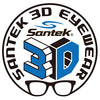 |
From the projector, left-eye and right-eye images with parallax, each having different rotational directions of polarization, are projected onto the screen.
To maintain the polarization characteristics of the left-eye and right-eye images on the projection screen, a 3D screen with anti-scattering treatment is used.
The images projected onto the 3D screen are viewed through circular polarized 3D glasses. The left and right lenses of these glasses are circular polarizing plates with different rotational directions, similar to the projector. By looking through the circular polarized 3D glasses, which have different polarizations for the left-eye and right-eye images, the left eye perceives the left-eye image, and the right eye perceives the right-eye image. Consequently, both eyes simultaneously perceive images with parallax, allowing the perception of depth.
As a result, the brain can recognize the two images with parallax entering the left and right eyes as a single image with a sense of depth.
Note: The linear polarizing plate in front of the projector and the circular polarizing plate in the lenses of the circular polarized 3D glasses need to have matching absorption axes. Before purchasing, please ensure that the specifications of the circular polarized 3D glasses from Santek and the polarizing plate in front of the projector match accordingly.
Important Note: Currently, our direct shopping page is designed for orders from Japan. However, we welcome orders from customers outside of Japan. Please submit a direct inquiry using the form below or send an email to s.shop@santek3d.jp .
Quote / Customization >>
Contact Us >>
Request Free Sample >>
|






